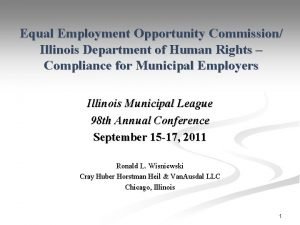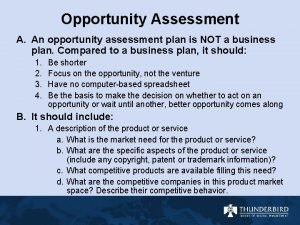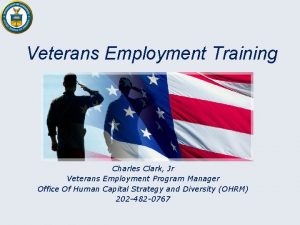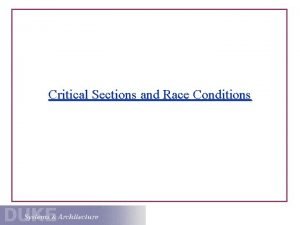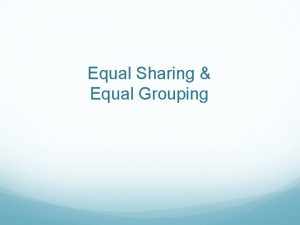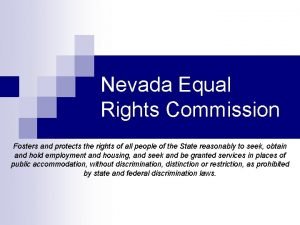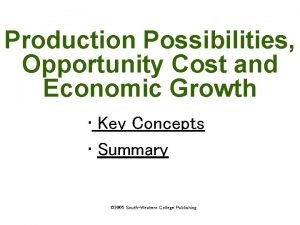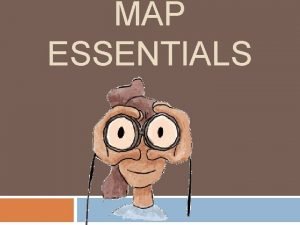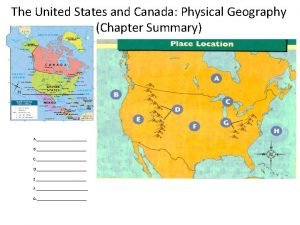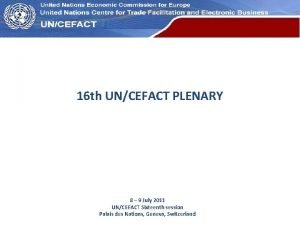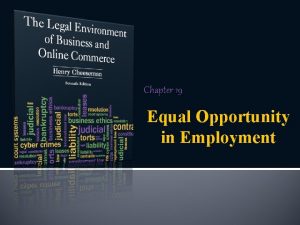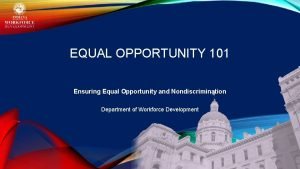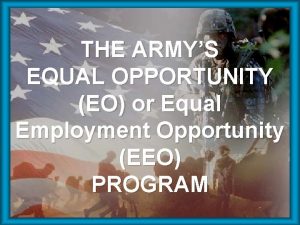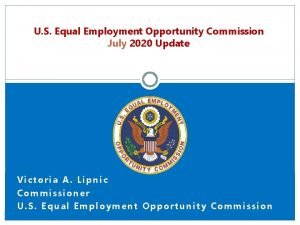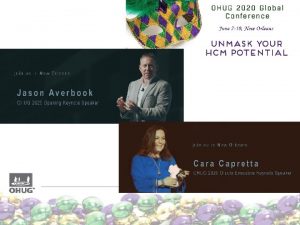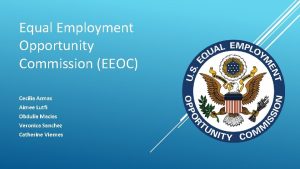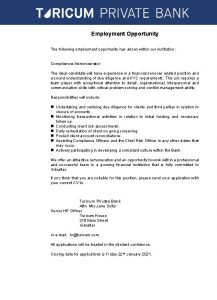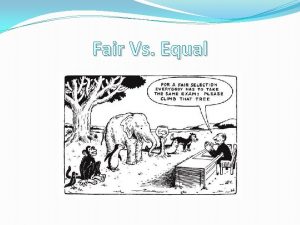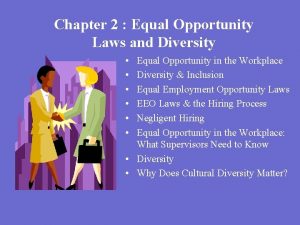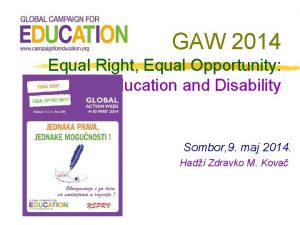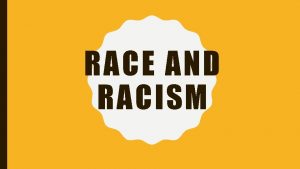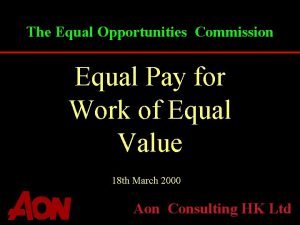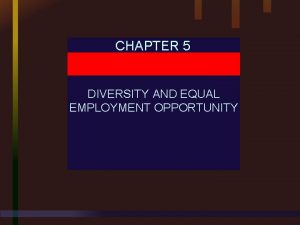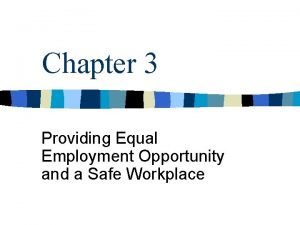UNITED STATES EQUAL EMPLOYMENT OPPORTUNITY COMMISSION Race and



























- Slides: 27

UNITED STATES EQUAL EMPLOYMENT OPPORTUNITY COMMISSION Race and Color Discrimination in the Workplace

TITLE VII OF THE CIVIL RIGHTS ACT OF 1964, AS AMENDED • • • PROTECTED BASES Race Color National Origin Religion Sex Retaliation (also applies to the ADA and ADEA)

Coverage: Race and Color • Title VII contains no definition of “race” or “color” • “Race” generally encompasses: – Ancestry – Physical characteristics – e. g. , hair – Cultural characteristics – e. g. , names, or accent / manner of speech – Perceived race – Association – Race “plus” – Intersection of protected bases – e. g. , race/religion; race/sex – “Reverse” race discrimination • “Color” generally means skin color

Five Minimum Race Categories Recognized by U. S. Government • American Indian or Alaskan Native • Asian • Black or African American • Native Hawaiian or Pacific Islander • White Ø Note that Hispanic/Latino is characterized as an ethnicity and not race because people of Hispanic/Latino ancestry can be of any race

Color Discrimination = pigmentation, complexion, skin shade or tone

Does Race Discrimination Still Exist?

Gallup Poll In a 2005 EEOC-sponsored Gallup poll: • 31% of Asian Americans surveyed reported having witnessed or experienced employment discrimination • 26% of African Americans reported witnessing or experiencing employment discrimination

CNN Poll In a December 2006 CNN poll: • 84% of African Americans and 66% of Caucasians surveyed think racism is a “very serious” or “somewhat serious” problem in America.

q Reality check ü ü ü Blacks are more than twice as likely to be unemployed lower-paying, less prestigious service jobs Blacks are more than twice as likely to be unemployed Census data – one third of all White employees hold professional managerial jobs – compared with slightly more than one fifth of all Blacks

Research • Criminal Record Study (Devah Pager, 2003) Blacks received job call-backs at a lower rate than Whites, even when White applicants had a criminal record and Blacks did not. Callback rates: • Whites without criminal record – 34% • Whites with criminal record – 17% • Blacks without criminal record – 14% • Blacks with criminal record – 5%

Research • Temp Agency Study (Discrimination Research Center, 2003) – California temporary agencies preferred White applicants three to one over African American applicants – Los Angeles: 4 to 1 – San Francisco: 2 to 1

What’s in a Name? 50% more likely to get a callback Neil Sarah Carrie Brendan Todd Rasheed Jamal Ebony Lakisha Latonya “Are Emily and Brendan More Employable than Lakisha and Jamal? , ” Marianne Bertrand Sendhil Mullainathan – 2002

Complexion Counts in Immigrant Wages – Joni Hersch, Vanderbilt University - 2007 • Survey of over 2000 legal immigrants • Those with lightest skin made 8%-15% more than those with darkest skin • One shade lighter had the same effect as an additional year of education • Other factors such as English-language proficiency , education, occupation, race and country were considered, but skin tone persisted as a determining factor

Color Pay Premium? Darkest Skin Lightest Skin Joni Hersch, Profiling the New Immigrant Worker: The Effects of Skin Color and Height, Journal of Labor Economics (Forthcoming 2008).

• • • What Causes Discrimination? Greed Laziness Attitudes Stereotypes Racism Ignorance Fear Low self-esteem Prejudice Bigotry

Implicit Bias What information do our brains implicitly provide when we walk into a conference room and see a person… Dressed a certain way Whose skin is darker or lighter

Measurement of Implicit Bias • The Implicit Assumption Test (IAT) IAT’s have been conducted at the website: https: //implicit. harvard. edu. • Measures implicit bias against explicit bias.

EEO & Technology • Technology provides more access to applicant information. For example: – Criminal and credit histories can be checked electronically – Internet search engines, social networking sites, video resumes, etc. , permit employers to rely on prohibited traits when making employment decisions

Disparate Treatment o Complainant is a member of a protected class, o Complainant was harmed, o Other employees of a different class were not harmed under similar circumstances, o The employer articulates a legitimate, nondiscriminatory reason for the harm, o The reason articulated by the employer is a pretext to hide discrimination.

Elements of Unlawful Workplace Harassment • Unwelcome conduct • Conduct is connected to a protected basis • Workplace Harm – Tangible Employment Action – Hostile Work Environment (severe or pervasive) • Employer Liability

Employer Liability – Tangible Employment Action • Employer is always liable. – Harassment by a supervisory official – Harasser had the authority to undertake or recommend a tangible employment decision affecting the victim – Harasser has the authority to direct the victim’s daily work activities

Hostile Work Environment Harassment • Does not result in a tangible employment action • Unreasonably interferes with an individual’s work performance • Creates an intimidating, hostile or offensive work environment • Anyone can commit this type of harassment – supervisor, co-worker, non employee

ADVERSE IMPACT • A policy or practice neutral on its face that disproportionately excludes members of a protected group. “Business Necessity Defense”: Practice/policy is job- related and consistent with business necessity. • Are there less discriminatory alternatives?

Retaliation • OPPOSITION to discrimination or PARTICIPATION in covered proceedings • ADVERSE ACTION • CAUSAL CONNECTION between the opposition or participation and the adverse action

Scenario #1 The intersection of discrimination and wage theft left Alicia, an administrative assistant at a major entertainment company, emotionally and financially battered. She endured years of racial slurs and disrespect. The hostile workplace turned into financial abuse when she says the company targeted African Americans for unpaid overtime – a common form of wage theft: “The other African American and I were doing double the hard work without being paid. My supervisor signed off on my 40 -hour a week time sheets while watching me work 60 - 70 hours a week for three to four years. ” Alicia and other African American workers were repeatedly passed over for promotions. When her complaints of discrimination fell on deaf ears at the company and she filed a federal complaint, she was retaliated against and ultimately fired, but not before having $20, 000 of her hard-earned wages stolen. Alicia turned to the Los Angeles Black Worker Center for help. After two years unemployed and able to recover just $6, 000 of her stolen earnings, Alicia says she learned, “without protection you will likely experience discrimination. ”

Scenario #2 A 33 year old Carpenter from Local 409. , and Engineering student at Los Angels Trade Tech. college. She acknowledges that Women make up 1% and Blacks %3 of the work force, and people can see that visually. Don’t need to be validated by opposite sex, ” It’s important to build power for ourselves” Mentioned language barriers can cause safety concerns, she hurt her finger due to the foreman saying drop a beam in Spanish. Was a former Laborer for 5 Months on a Clark construction project, didn’t like the trade not respected a lot of racism and nepotism. On union job sites Latino workers made her feel like, “why are you here”, and the work is theirs.

Scenario #3 • Gerry Kennon is only 33 has been in the Trades for over 14 years. Gerry has been undergoing an immense amount of isolation, and language discrimination at his latest job. Labor standards are lowered resulting in Gerry to undergo Language discrimination. His safety meetings for his current job are held in Spanish which is a huge concern to his safety and self esteem as no one attempted to translate in English contributing to his isolation. When Gerry asked how could he advance with his current company he was told by the Foreman that he could not advance because he did not speak Spanish.
 Equal employment opportunity illinois
Equal employment opportunity illinois Pelton turbine efficiency
Pelton turbine efficiency Dams design
Dams design Opportunity recognition and opportunity assessment plan
Opportunity recognition and opportunity assessment plan Veoa vs vra
Veoa vs vra Data race vs race condition
Data race vs race condition Equal opportunity and the law chapter 2
Equal opportunity and the law chapter 2 Equal grouping is called
Equal grouping is called Equal opportunity fund
Equal opportunity fund Equal height equal light
Equal height equal light Taku graphics
Taku graphics Opposite angles are equal
Opposite angles are equal Meridionalnet
Meridionalnet Graduated commission definition
Graduated commission definition Kara jenkins nevada
Kara jenkins nevada The law of increasing opportunity costs states that
The law of increasing opportunity costs states that Awake united states
Awake united states United states and canada physical map
United states and canada physical map Map of latitude lines
Map of latitude lines Settlement patterns
Settlement patterns Slidetodoc.com
Slidetodoc.com United states history and government regents
United states history and government regents Chapter 5 section 1 landforms and resources
Chapter 5 section 1 landforms and resources The united states emerges as a world power
The united states emerges as a world power United nations economic commission for europe
United nations economic commission for europe Aims and objectives of mudaliar commission
Aims and objectives of mudaliar commission Ratio warm up
Ratio warm up Was the united states on the axis powers or allied powers?
Was the united states on the axis powers or allied powers?
